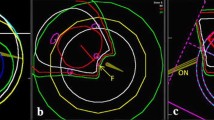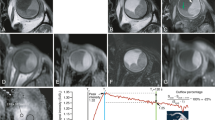Abstract
Introduction
Uveal melanoma is a rare intraocular tumor with heterogeneous biological behavior, and additional noninvasive markers that may predict outcome are needed. Diffusion- and perfusion-weighted imaging may prove useful but have previously been limited in their ability to evaluate ocular tumors. Our purpose was to show the feasibility and potential value of a multiparametric (mp-) MRI protocol employing state of the art diffusion- and perfusion-weighted imaging techniques.
Methods
Sixteen patients with uveal melanoma were imaged with mp-MRI. Multishot readout-segmented echoplanar diffusion-weighted imaging, quantitative dynamic contrast-enhanced (DCE) MR perfusion imaging, and anatomic sequences were obtained. Regions of interest (ROIs) were drawn around tumors for calculation of apparent diffusion coefficient (ADC) and perfusion metrics (K trans, v e , k ep , and v p ). A generalized linear fit model was used to compare various MRI values with the American Joint Commission on Cancer (AJCC) tumor group and monosomy 3 status with significance set at P < 0.05.
Results
mp-MRI was performed successfully in all cases. MRI tumor height (mean [standard deviation]) was 6.5 mm (3.0). ROI volume was 278 mm3 (222). ADC was 1.07 (0.27) × 10–3 mm2/s. DCE metrics were K trans 0.085/min (0.063), v e 0.060 (0.052), k ep 1.20/min (0.32), and v p 1.48 % (0.82). Patients with >33 % monosomy 3 had higher K trans and higher v e values than those with disomy 3 or ≤33 % monosomy (P < 0.01). There were no significant differences between ADC (P = 0.07), k ep (P = 0.37), and v p with respect to monosomy 3.
Conclusion
mp-MRI for ocular tumor imaging using multishot EPI DWI and quantitative DCE perfusion is technically feasible. mp-MRI may help predict monosomy 3 in uveal melanoma.



Similar content being viewed by others
Abbreviations
- DWI:
-
Diffusion-weighted imaging
- DCE:
-
Dynamic contrast-enhanced
- ADC:
-
Apparent diffusion coefficient
- CISS:
-
Constructive interference in steady state
- EPI:
-
Echoplanar imaging
References
Damato B (2000) Current management of uveal melanoma. Ophthalmic Physiol Opt 20:S8–S9
Chang MY, Rao NP, Burgess BL, Johnson L, McCannel TA (2013) Heterogeneity of monosomy 3 in fine needle aspiration biopsy of choroidal melanoma. Mol Vis 19:1892–1900
Stroszczynski C, Hosten N, Bornfeld N et al (1998) Choroidal hemangioma: MR findings and differentiation from uveal melanoma. AJNR Am J Neuroradiol 19:1441–1447
Erb-Eigner K, Willerding G, Taupitz M et al (2013) Diffusion-weighted imaging of ocular melanoma. Invest Radiol 48:702–707. doi:10.1097/RLI.0b013e31828eea67
Sepahdari AR, Kapur R, Aakalu VK, Villablanca JP, Mafee MF (2012) Diffusion-weighted imaging of malignant ocular masses: initial results and directions for further study. AJNR Am J Neuroradiol 33:314–319. doi:10.3174/ajnr.A2747
Rosset A, Spadola L, Ratib O (2004) OsiriX: an open-source software for navigating in multidimensional DICOM images. J Digit Imaging 17:205–216. doi:10.1007/s10278-004-1014-6
Ishimori Y, Kimura H, Uematsu H, Matsuda H, Matsuda T, Itoh H (2003) Dynamic T1 estimation of brain tumors using double-echo dynamic MR imaging. J Magn Reson Imaging 18:113–120. doi:10.1002/jmri.10331
Vonken EJ, van Osch MJ, Bakker CJ, Viergever MA (1999) Measurement of cerebral perfusion with dual-echo multi-slice quantitative dynamic susceptibility contrast MRI. J Magn Reson Imaging 10:109–117
Tofts P, Kermode A (1991) Measurement of the blood‐brain barrier permeability and leakage space using dynamic MR imaging. 1. Fundamental concepts. Magn Reson Med 17:357–67
Tofts PS, Brix G, Buckley DL et al (1999) Estimating kinetic parameters from dynamic contrast-enhanced T(1)-weighted MRI of a diffusable tracer: standardized quantities and symbols. J Magn Reson Imaging 10:223–232
Cramer SP, Simonsen H, Frederiksen JL, Rostrup E, Larrson HBW (2013) Abnormal blood–brain barrier permeability in normal appearing white matter in multiple sclerosis investigated by MRI. Neuroimage Clin 4:182–189. doi:10.1016/j.nicl.2013.12.001
de Graaf P, Pouwels PJW, Rodjan F et al (2012) Single-shot turbo spin-echo diffusion-weighted imaging for retinoblastoma: initial experience. AJNR Am J Neuroradiol 33:110–118. doi:10.3174/ajnr.A2729
Pulido JS, Campeau NG, Klotz E et al (2008) Correlation of histological findings from a large ciliochoroidal melanoma with CT perfusion and 3T MRI dynamic enhancement studies. Clin Ophthalmol 2:275–281
Daftari IK, Aghaian E, O’Brien JM, Dillon WP, Phillips TL (2005) 3D MRI-based tumor delineation of ocular melanoma and its comparison with conventional techniques. Med Phys 32:3355–3362
Foti PV, Farina R, Coronella M et al (2015) Diffusion-weighted magnetic resonance imaging for predicting and detecting the response of ocular melanoma to proton beam therapy: initial results. Radiol Med. doi:10.1007/s11547-014-0488-7
Yuan Y, Kuai XP, Chen XS, Tao XF (2013) Assessment of dynamic contrast-enhanced magnetic resonance imaging in the differentiation of malignant from benign orbital masses. Eur J Radiol 82:1506–1511. doi:10.1016/j.ejrad.2013.03.001
Prescher G, Bornfeld N, Hirche H, Horsthemke B, Jockel KH, Becher R (1996) Prognostic implications of monosomy 3 in uveal melanoma. Lancet 347:1222–1225
Chang SH, Worley LA, Onken MD, Harbour JW (2008) Prognostic biomarkers in uveal melanoma: evidence for a stem cell-like phenotype associated with metastasis. Melanoma Res 18:191–200. doi:10.1097/CMR.0b013e3283005270
Mouriaux F, Sanschagrin F, Diorio C et al (2014) Increased HIF-1α expression correlates with cell proliferation and vascular markers CD31 and VEGF-A in uveal melanoma. Invest Ophthalmol Vis Sci 55:1277–1283. doi:10.1167/iovs.13-13345
Sheidow TG, Hooper PL, Crukley C, Young J, Heathcote JG (2000) Expression of vascular endothelial growth factor in uveal melanoma and its correlation with metastasis. Br J Ophthalmol 84:750–756
Sourbron SP, Buckley DL (2011) On the scope and interpretation of the Tofts models for DCE-MRI. Magn Reson Med 66:735–745. doi:10.1002/mrm.22861
Koh TS, Bisdas S, Koh DM, Thng CH (2011) Fundamentals of tracer kinetics for dynamic contrast-enhanced MRI. J Magn Reson Imaging 34:1262–1276. doi:10.1002/jmri.22795
Jain R (2013) Measurements of tumor vascular leakiness using DCE in brain tumors: clinical applications. NMR Biomed 26:1042–1049. doi:10.1002/nbm.2994
Ethical standards and patient consent
We declare that all human and animal studies have been approved by the UCLA Institutional Review Board and the UCLA Jonsson Comprehensive Cancer Center, and have therefore been performed in accordance with the ethical standards laid down in the 1964 Declaration of Helsinki and its later amendments. Patient consent was waived for the use of patient records in this research study.
Conflict of interest
We declare that we have no conflict of interest.
Author information
Authors and Affiliations
Corresponding author
Additional information
Mitchell Kamrava and Ali R Sepahdari contributed equally to this work.
Rights and permissions
About this article
Cite this article
Kamrava, M., Sepahdari, A.R., Leu, K. et al. Quantitative multiparametric MRI in uveal melanoma: increased tumor permeability may predict monosomy 3. Neuroradiology 57, 833–840 (2015). https://doi.org/10.1007/s00234-015-1546-0
Received:
Accepted:
Published:
Issue Date:
DOI: https://doi.org/10.1007/s00234-015-1546-0




